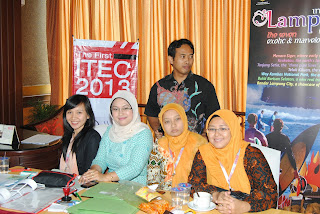Changes
necessary in teaching and learning strategies
The
article was taken from Rosnani Hashim (ITEC 2013, University of
Lampung, Indonesia)
Institute
of Education, International Islamic University Malaysia
In the past
our learning and teaching strategies were basically concerned on
cognitive understanding and retention of facts or content. At most
we would like our students to be able to apply these facts in solving
some problems in their daily lives, in examinations and in most cases
as foundations for further higher learning. Basically it is the
lower order of the Bloom’s taxonomy i.e. knowledge, understanding
and application. It rarely attempts to do much analysis, evaluation
and synthesis which are the higher order of the Bloom’s taxonomy
that are crucial for critical and creative thinking, for proper
judgement and good decision making. This are only provided at the
end of high school or in the university. This was alright for a
system of education that desires to sort out students based on grades
to fit into the available occupational positions. Moreover the
system was elitist then and meant to choose the best brains.
But today
with technological changes and innovation, where information is
accessible to all and the world grows more competitive, leading to a
different kind of worker i.e the knowledge worker, the focus on
education is not only on the products or the contents but more
importantly on the process or the skills necessary to enable the
formulation of a solution. As educators, we need to adapt our lesson
presentations to these digitally “programmed” students. There is
little hope that these digital natives will “power down” their
minds to become more engaged with traditional learning styles
(Pensky, 2001).
It is
interesting how the changes of the present era was envisaged as early
as 1916 when Dewey published his seminal work "Democracy and
Education", which acknowledged that learners should become
active participants in the educational process. The idea is that in
learning from their own experience, students become, in a sense,
their own teachers. The changed role of the learner has, in turn,
implications for that of the teacher. Instead of the source of
knowledge, teachers become facilitators of the learning process; that
is, their role is to create the set of conditions under which
students can best learn from their experiences. Moreover, teachers
can fulfill this role only by becoming learners themselves, and a
primary source of their learning must be their students. In a
nutshell, teachers who learn become better teachers, and learners who
teach become better learners. Although this idea seems
straightforward enough, educators have been very slow to put it into
practice. However, the rapid technological changes of the last few
decades may well provide the catalyst that finally brings about these
needed reforms in the field of education (Florin, L.& S. Sugioka,
2007).
Teaching and
learning strategies today have to foster communication skills which
in this century would mean proficiency in the English language,
critical and creative thinking skills, and inter-personal and
collaborative skills. The issue is how to foster these skills
through teaching and learning. Good communication skills require the
students to speak up and not just to listen and digest all that the
lecturer informs them. Thus, a lecture is not suitable all the
times. There ought to be discussion where students can express their
ideas and also their views – however sloppy it might seems at
first. The conversation should also be between students and students
and not only between teacher and students. Only when the proper
language is used will it be alive. Discussion can also be taken up
into small group.
To foster
critical thinking skills, students ought to be trained to reason well
and be analytical. They must be able to give reasons for their
belief. They must be able to provide evidence for their argument,
give examples to illustrate, identify fallacies in reasoning, to
think logically, through induction or deduction and to recognize
valid and sound arguments. This can be done through analytical
written exercises or in classroom discussion. To foster creative
thinking, students have to be taught to sometimes think outside of
the box or to be imaginative.
To foster
collaborative skills and work as a team, students need to be
encouraged to do some form of group or project work where each member
is given a task to be worthy.




























































